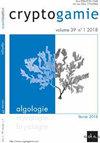巨型洞穴(意大利的里雅斯特)的隐藻多样性:Timaviella新属(细藻科)
IF 1.5
4区 生物学
Q3 MARINE & FRESHWATER BIOLOGY
引用次数: 31
摘要
摘要:国内外对低温环境微生物区系的研究日益深入。然而,有些地点几乎没有被检查或根本没有被研究;这就是位于意大利的里雅斯特附近的一个喀斯特洞穴。在本研究中,我们开始使用多相方法来表征巨洞蓝藻,特别关注三种被命名为GR2, GR4和GR13的lepolylynbya样菌株。进行了光镜和电镜观察,并对水溶性色素组成进行了分析。基于16S rRNA基因和16S- 23s ITS区域进行系统发育重建,以更好地了解这些菌株的分类位置,并结合16S- 23s ITS二级结构分析。研究菌株的生态和地理数据以及与之类群的其他蓝藻菌株在系统发育重建中也进行了考虑。根据上述结果,菌株GR2归属于紫癜异白菌(Hansgirg) Anagnostidis & Komárek;菌株GR4和GR13归属于麻麻科新属Timaviella Sciuto & Moro, gen. nov.,代表两个不同的种:circinata Timaviella Sciuto & Moro和karstica Timaviella Sciuto & Moro。本文章由计算机程序翻译,如有差异,请以英文原文为准。
Cryptic Cyanobacterial Diversity in the Giant Cave (Trieste, Italy): The New Genus Timaviella (Leptolyngbyaceae)
Abstract
The microflora of hypogean environments has been studied increasingly worldwide. However, some sites have hardly been examined or not studied at all; this is the case for the Giant Cave, a Karst show cave located near Trieste, Italy. In the present study we began characterizing the Giant Cave Lampenflora by using a polyphasic approach, focusing, in particular, on three Leptolyngbya-like strains named GR2, GR4, and GR13. Light and electron microscopic observations were carried out and the water-soluble pigment composition was analysed. Phylogenetic reconstruction, based on the 16S rRNA gene and the 16S-23S ITS region, was performed to better understand the taxonomic position of these strains, complemented by 16S-23S ITS secondary structure analysis. Ecological and geographical data for the investigated strains and for the other cyanobacterial strains grouping with them in the phylogenetic reconstructions were also considered. Based on the results, strain GR2 was ascribed to the species Heteroleibleinia purpurascens (Hansgirg) Anagnostidis & Komárek; strains GR4 and GR13 were attributed to a new genus of the family Leptolyngbyaceae, Timaviella Sciuto & Moro, gen. nov., and represented two distinct species: Timaviella circinata Sciuto & Moro and Timaviella karstica Sciuto & Moro.
求助全文
通过发布文献求助,成功后即可免费获取论文全文。
去求助
来源期刊

Cryptogamie Algologie
生物-海洋与淡水生物学
CiteScore
2.60
自引率
7.70%
发文量
11
审稿时长
>12 weeks
期刊介绍:
Cryptogamie is a fast-track and peer-reviewed journal of international scope publishing in English only. It accepts original papers and review articles on the taxonomy, biology and ecology of all cryptogams. An issue of Cryptogamie may be devoted to a single topic, under the responsibility of guest editor(s). All articles published in Cryptogamie are compliant with the different nomenclatural codes. A copyright assignment will be signed by the authors before publication.
Cryptogamie, Algologie accepts articles on systematics as well as ecology and evolution of any kind of algae (including Cyanobacteria).
 求助内容:
求助内容: 应助结果提醒方式:
应助结果提醒方式:


